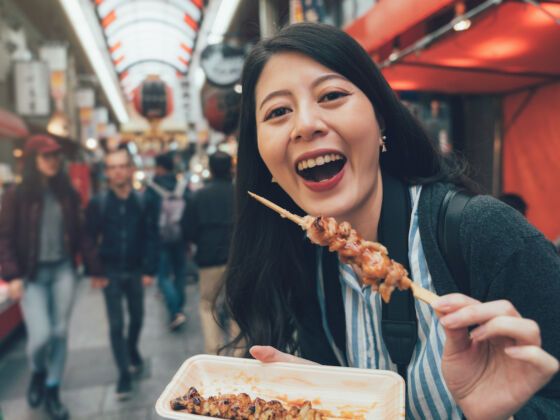I’m allergic to milk, eggs, and cheese, so traveling to an Asian country where the cuisine matured without these European staples was rather liberating. I was safe from my other allergies as long as I clung to traditional Japanese foods and avoided “Westernized” products like food gussied up with tree nuts, meals that came with salad, or botched concepts like “peanut cream.”

Any hostel I booked had to have a stovetop, and I purposely chose to participate in WWOOF so that I could be in a house with a kitchen. My pre-existing knowledge of Japanese culture was invaluable, and experience from cooking recipes in my Los Angeles kitchen allowed me to transfer that knowledge to the international frying pan.
My last trip to Japan was for six weeks, some of it in guest houses, some of it on farms, and some of it on the go. I only had one incident where I woke up at 3 am ill. The culprit? Expired ketchup.
Here are some tips and a phrase guide that can help you navigate Japanese culture and cuisine without setting off an allergic reaction.
1. Know the Basics of Japanese Cuisine
Familiarize yourself with Japanese food before you leave. Go to a Japanese grocery store to browse the shelves, as most products will have translated labels stuck over the Japanese ones. Take pictures if it will help you identify problem products or ingredients.
You can also read Japanese cookbooks, go to Japanese restaurants, or browse menus online to orient yourself with the cuisine and its staples. Be aware that many Japanese restaurants often mix Chinese or Korean fare into the menu, like lo mein or bulgogi.
There are five basics of Japanese cuisine can be recalled through a mnemonic – sa, shi, su, se, and so. These are, respectively: sato (sugar), shio (salt), su (rice vinegar), shoyu (soy sauce), and miso (fermented soybean paste). Any authentic Japanese kitchen, will also have katsubushi (fish flakes for stock) and kombu (a variety of seaweed) on hand.
2. Choose Safety Dishes for Eating Out
It’s a great idea to have a couple safety dishes you can order if you can’t read a restaurant menu. I have four: kitsune udon, sake ochazuke, sabashioyaki, and inarizushi.
Ordering food in Japanese is simple, and most businesses will do their best to accommodate you. Restaurants often have a glass case outside displaying plastic replicas of their fare. I recommend eating at kaiten sushi (conveyor belt sushi) places or “meal ticket” restaurants; avoid locations with menus that force you to order combinations, as this method can be confusing.
3. Cook and Eat In
You can have more control over your diet if you self-cater or stay with a host family. Allergies are not that common in Japan, but Japanese people are most often willing to work with your dietary restrictions.
If you’re staying with a host at a home or farmstay (highly recommended!), express your allergies clearly before arrival. Your host may be hesitant, so reassure them by offering to cook for or with them.
Take note that Japan uses the metric system, so if you’re an American, you will have to convert your favorite recipes; I learned this the hard way. Japanese families do not typically bake, and many households don’t have ovens or traditional baking ingredients. Microwaves, stove-tops, and toaster ovens for broiling fish are common.
In Japan, shopping at konbini (convenience stores) or supaa (supermarkets) allows plenty of time to make the right shopping choices; it will be harder when you have to eat on the go.
4. Bring Your Meds and Be Prepared
Make sure you see an allergist before your departure and ask if he can give you a printout with your allergens listed. Don’t forget your Epi-pen. Airport security has never given me a hard time about my pen, but if you feel uneasy about bringing a needle in your luggage, ask your doctor for a medical note.
Pack non-drowsy Benedryl for emergencies. It’s a good idea to pack aspirin too, as it’s rather pricey in Japan. I would also recommend bringing a travel toothbrush in case you eat something toxic and have to cleanse your mouth.
5. Have a System for Encountering New Foods
If you are unsure if a food will sicken you or not, complete this four-step test:
1. Visually inspect it. Spread it out, and smell it. Is it rich? Is it gooey? Is it fishy?
2. Dab it on your skin. Your skin may redden if the food is warm or spicy, so gauge for swelling or hives. Wash with soap and warm water if a reaction occurs.
3. If it passed the skin test, dab a small amount on your tongue. Wait up to five minutes.
4. If nothing has happened, take your first bites slowly. If you feel anything odd, stop eating immediately.